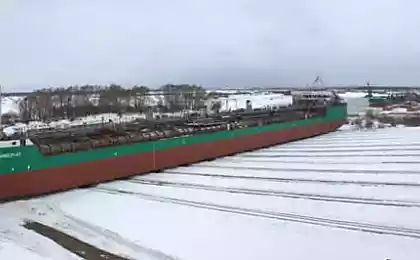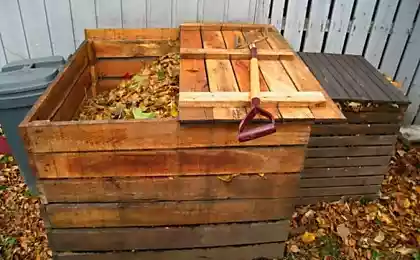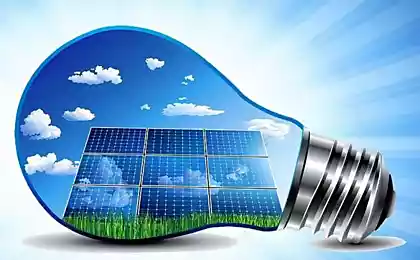3234
Biomeiler: heating with compost is an inexpensive way to heat water and to heat the house
Today we tell you about an old but little-known, effective and inexpensive way to heat water instead of the boiler and to heat the house. More thought out idea with almost half a century of experience.
Biominer — heating compost is very old. We can say, as old as the old civilization. Moreover, it is likely that dinosaurs also used the heating with compost — just like a modern wild boars. My family leaves were taken out to the site and was in a huge pile — waiting for ignition. But no time for that in heaps in the morning you can always find a few "beds" — holes where the sleeping boars. The reason is simple: while pregnany compost generates a lot of heat.
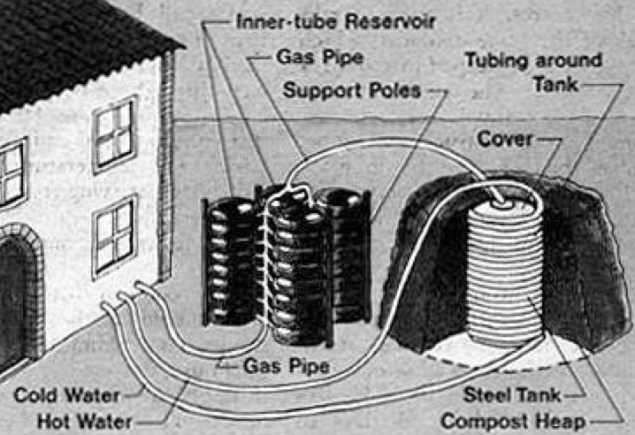
But humans are not animals, and they were able to organize even heating with compost where compost was not. For example — biemiller, technology from Germany, which we will describe with pictures and video. But first a bit of theory about composting.
Compost (kom — prefix "with -" post — root meaning "to lay down" = "addition"; the root word is compote) is a process where organic substances are converted into humus with the help of bacteria, water and oxygen. However, there is a temperature and carbon dioxide.
Biemiller German word from bio (biological) and myler (before oven for burning charcoal; now the Atommeiler nuclear reactor).
Biomeiler — technology compost heating, consisting of two circuits:
A compost heap in which are buried a few "floors" of the heating pipes (first circuit).
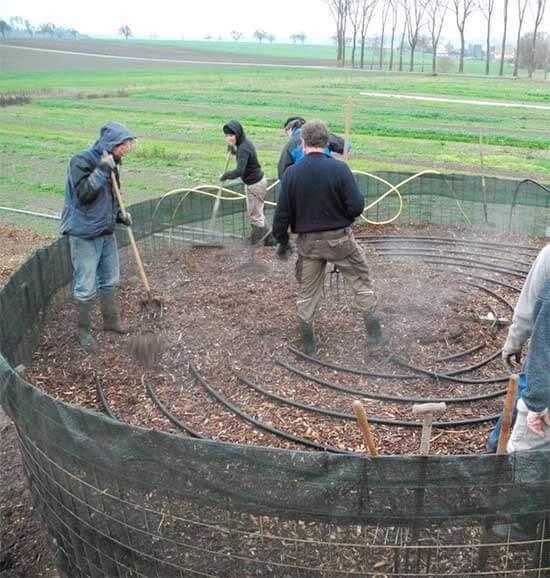
The second option of winding tubes on the core in the hot zone of a compost heap:
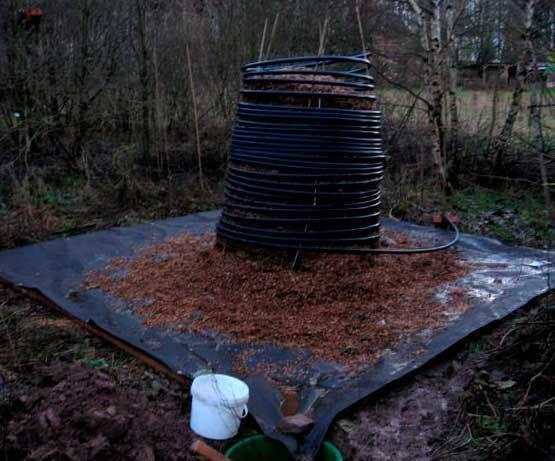
Pipe horizontal rows take more heat, but more difficult to disassemble the pile after digestion. Pipe core is much easier to remove, but give less heat.
A heat exchanger collecting heat from these tubes and passes to the second circuit.
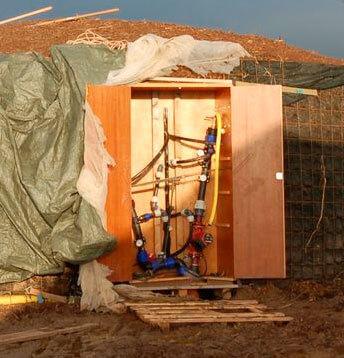
The second circuit — home heating or hot water at home.
The principle of operation technology biemiller:
It's very simple:
1. Compost rot, warms the first circuit.
2. The heat exchanger transfers heat to the second contour.
3. The user uses either heating or hot water.
From the point of view of the duration of operation of the heat exchanger the water is soften.
But there are a few details that are worth considering.
Aeration of the compost pile to heat the house
A compost heap should be of sufficient size to prevent rapid loss of heat and moisture, and provide efficient aeration throughout the volume.
When composting material in piles in conditions of natural aeration is not recommended to stack more than 1.5 m in height and 2.5 m in width, otherwise the diffusion of oxygen to the center of the pile will be difficult. This bunch may be stretched in the compost a number of any length.
With a larger pile to the center pile is inserted into a hollow cylinder, through which can pass the air. This is to allow the aerated pile and inside.
That's why it's a compost heap, not the pit. And that is why the frame — reticle (or a bunch of frameless) — no walls, partitions, etc. — it affects the breathability.
Also the air exchange is improved, if the pile leans over a couple of layers of pallets or a thick layer of thick branches and Valeron — air can pass and bottom.
Compost heap regularly "daravitsa" scrap in all directions — create channels for air penetration. But daravitsa carefully, as in a heap of buried pipes with coolant.
The ratio of nitrogen and carbon in the compost to heat water
Also for composting is important, the ratio of nitrogen and carbon. The "green" part of the compost of grass, leaves, eggshells, fruit and vegetable wastes, etc. contain much more nitrogen. The "brown" part — branches, twigs, sawdust, etc. contain more carbon. If a lot of nitrous components, the temperature increases faster. However, there's lots of ammonia (nitrogen-containing compound) which kills bacteria. And so might "die".
The optimum proportion is about 25 % green compost and 75 % "brown". Stir them carefully to avoid areas of decay.
That is why below the video you will notice that the heap does not consist of grass, but mostly of crushed branches.
Managing heat transfer in technology Biemiller
The temperature of the composting depends on the stage of composting:
1. The initial stage when working with low temperature bacteria. Depends on air access and the availability of water.
2. The second stage is the growth temperature. Are bacteria that can withstand higher temperature. They multiply, the temperature rises. From ambient temperature to 45-50 degrees Celsius.
3. The third stage maximum temperature. Value is 65-70 degrees. Are only bacteria that can withstand this temperature. At this stage there is a rapid dehydration of the compost. And very rapid consumption of organic matter. The more this phase, the faster comes the next.
4. The fourth stage — the temperature is again about 40 degrees Celsius — when food for bacteria and there is little water left.
The question is, how long does each stage. It depends on many factors, and the spread can be almost in 10 times. But speed can be influenced, in the first place — water. The most critical and high temperature, which would slow down (because it lasts sometimes only a week) — the third stage.
The optimal humidity of the compost – 60-70%. Obviously, the lower the humidity, the slower the decay (and the lower the temperature). And Vice versa — more water, more temperature, less time will serve for the compost heating.
Therefore, you need to decide
Also on the temperature composting can be affected by cooling.
The mechanism is simple: the heat from a compost heap in technology Biemiller selected through the heat exchanger and goes into the house. Therefore, you need to rapidly take away the water — cooled heat exchanger, heating circuit with the heap of compost cools, and cools the compost.
So, it's simple — but not so to lie belly up, like a Central heating system. But independence from external energy sources, which in modern conditions is important.
But let's move from theory to practice:
Exactly how organized technology Biemiller.
About this video (which, in particular, explains the first picture to the article; the tank in the center for education of biogas is oxygen-free process, but in the center of the heap, that it was warmer):
More videos (long and very very detailed):
And another video about the mini-biobaler:
Key question: how much hot water we get from biemiller? Here is the answer from the German site:
Biomeiler 50 tons and 120 m3 of compost (heap about 5 meters in diameter and 2.5 m in height), with 200 meters of pipe inside the compost constantly produces 4 liters of water per minute at about 60 degrees Celsius (with an initial water temperature of 10 degrees). This is equal to 240 litres of water per hour = 10 kW (much like 1 litres of liquid fuel). A bunch of 50 tons running from 10 months.
How to make a water filter with your hands: a review of the most popular homemade
Two-pipe heating system with lower wiring: a diagram that will help you save
By the way, a caveat: you can use 2 lines in the compost heap. One of the water pipes, for heating water. And the second duct for air heating (air heating). In the "air" does not need a heat exchanger; pipe takes the cold air from the floor and gets hot.
You also need to consider: a lot more than 50 tons practically does not react to winter frosts. Mini similary "freeze" in the winter and spring will work again.
The calculation of similara
Round base
Diameter
Height
Area
Layers
The volume
Energy output
m
m
m2
things
m3
kW
4
2.1
13
2
20
1.1
5
2.8
20
3
40
2.6
6
2.8
28
3
60
4.2
7
3.5
37
4
100
7.9
8
3.5
50
4
145
11.3
Successful realization of the compost heating by Biomeiler! published
Author: Lion Dock
Put LIKES and share with your FRIENDS!
www.youtube.com/channel/UCXd71u0w04qcwk32c8kY2BA/videos
Source: interesko.info/biomeiler-otoplenie-kompostom/
Biominer — heating compost is very old. We can say, as old as the old civilization. Moreover, it is likely that dinosaurs also used the heating with compost — just like a modern wild boars. My family leaves were taken out to the site and was in a huge pile — waiting for ignition. But no time for that in heaps in the morning you can always find a few "beds" — holes where the sleeping boars. The reason is simple: while pregnany compost generates a lot of heat.

But humans are not animals, and they were able to organize even heating with compost where compost was not. For example — biemiller, technology from Germany, which we will describe with pictures and video. But first a bit of theory about composting.
Compost (kom — prefix "with -" post — root meaning "to lay down" = "addition"; the root word is compote) is a process where organic substances are converted into humus with the help of bacteria, water and oxygen. However, there is a temperature and carbon dioxide.
Biemiller German word from bio (biological) and myler (before oven for burning charcoal; now the Atommeiler nuclear reactor).
Biomeiler — technology compost heating, consisting of two circuits:
A compost heap in which are buried a few "floors" of the heating pipes (first circuit).

The second option of winding tubes on the core in the hot zone of a compost heap:

Pipe horizontal rows take more heat, but more difficult to disassemble the pile after digestion. Pipe core is much easier to remove, but give less heat.
A heat exchanger collecting heat from these tubes and passes to the second circuit.

The second circuit — home heating or hot water at home.
The principle of operation technology biemiller:
It's very simple:
1. Compost rot, warms the first circuit.
2. The heat exchanger transfers heat to the second contour.
3. The user uses either heating or hot water.
From the point of view of the duration of operation of the heat exchanger the water is soften.
But there are a few details that are worth considering.
Aeration of the compost pile to heat the house
A compost heap should be of sufficient size to prevent rapid loss of heat and moisture, and provide efficient aeration throughout the volume.
When composting material in piles in conditions of natural aeration is not recommended to stack more than 1.5 m in height and 2.5 m in width, otherwise the diffusion of oxygen to the center of the pile will be difficult. This bunch may be stretched in the compost a number of any length.
With a larger pile to the center pile is inserted into a hollow cylinder, through which can pass the air. This is to allow the aerated pile and inside.
That's why it's a compost heap, not the pit. And that is why the frame — reticle (or a bunch of frameless) — no walls, partitions, etc. — it affects the breathability.
Also the air exchange is improved, if the pile leans over a couple of layers of pallets or a thick layer of thick branches and Valeron — air can pass and bottom.
Compost heap regularly "daravitsa" scrap in all directions — create channels for air penetration. But daravitsa carefully, as in a heap of buried pipes with coolant.
The ratio of nitrogen and carbon in the compost to heat water
Also for composting is important, the ratio of nitrogen and carbon. The "green" part of the compost of grass, leaves, eggshells, fruit and vegetable wastes, etc. contain much more nitrogen. The "brown" part — branches, twigs, sawdust, etc. contain more carbon. If a lot of nitrous components, the temperature increases faster. However, there's lots of ammonia (nitrogen-containing compound) which kills bacteria. And so might "die".
The optimum proportion is about 25 % green compost and 75 % "brown". Stir them carefully to avoid areas of decay.
That is why below the video you will notice that the heap does not consist of grass, but mostly of crushed branches.
Managing heat transfer in technology Biemiller
The temperature of the composting depends on the stage of composting:
1. The initial stage when working with low temperature bacteria. Depends on air access and the availability of water.
2. The second stage is the growth temperature. Are bacteria that can withstand higher temperature. They multiply, the temperature rises. From ambient temperature to 45-50 degrees Celsius.
3. The third stage maximum temperature. Value is 65-70 degrees. Are only bacteria that can withstand this temperature. At this stage there is a rapid dehydration of the compost. And very rapid consumption of organic matter. The more this phase, the faster comes the next.
4. The fourth stage — the temperature is again about 40 degrees Celsius — when food for bacteria and there is little water left.
The question is, how long does each stage. It depends on many factors, and the spread can be almost in 10 times. But speed can be influenced, in the first place — water. The most critical and high temperature, which would slow down (because it lasts sometimes only a week) — the third stage.
The optimal humidity of the compost – 60-70%. Obviously, the lower the humidity, the slower the decay (and the lower the temperature). And Vice versa — more water, more temperature, less time will serve for the compost heating.
Therefore, you need to decide
- what temperature water is needed
- how long
Also on the temperature composting can be affected by cooling.
The mechanism is simple: the heat from a compost heap in technology Biemiller selected through the heat exchanger and goes into the house. Therefore, you need to rapidly take away the water — cooled heat exchanger, heating circuit with the heap of compost cools, and cools the compost.
So, it's simple — but not so to lie belly up, like a Central heating system. But independence from external energy sources, which in modern conditions is important.
But let's move from theory to practice:
Exactly how organized technology Biemiller.
About this video (which, in particular, explains the first picture to the article; the tank in the center for education of biogas is oxygen-free process, but in the center of the heap, that it was warmer):
More videos (long and very very detailed):
And another video about the mini-biobaler:
Key question: how much hot water we get from biemiller? Here is the answer from the German site:
Biomeiler 50 tons and 120 m3 of compost (heap about 5 meters in diameter and 2.5 m in height), with 200 meters of pipe inside the compost constantly produces 4 liters of water per minute at about 60 degrees Celsius (with an initial water temperature of 10 degrees). This is equal to 240 litres of water per hour = 10 kW (much like 1 litres of liquid fuel). A bunch of 50 tons running from 10 months.
How to make a water filter with your hands: a review of the most popular homemade
Two-pipe heating system with lower wiring: a diagram that will help you save
By the way, a caveat: you can use 2 lines in the compost heap. One of the water pipes, for heating water. And the second duct for air heating (air heating). In the "air" does not need a heat exchanger; pipe takes the cold air from the floor and gets hot.
You also need to consider: a lot more than 50 tons practically does not react to winter frosts. Mini similary "freeze" in the winter and spring will work again.
The calculation of similara
Round base
Diameter
Height
Area
Layers
The volume
Energy output
m
m
m2
things
m3
kW
4
2.1
13
2
20
1.1
5
2.8
20
3
40
2.6
6
2.8
28
3
60
4.2
7
3.5
37
4
100
7.9
8
3.5
50
4
145
11.3
Successful realization of the compost heating by Biomeiler! published
Author: Lion Dock
Put LIKES and share with your FRIENDS!
www.youtube.com/channel/UCXd71u0w04qcwk32c8kY2BA/videos
Source: interesko.info/biomeiler-otoplenie-kompostom/
Drink water with turmeric every morning and you will see what happens!
Greenhouse gas emissions are stabilized





